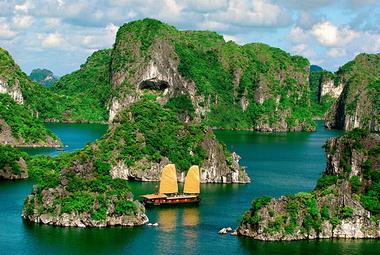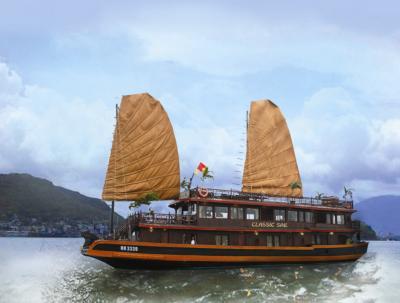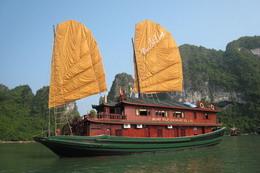Fast growing cities muddy green space
Published: 05/03/2009 05:00
| LookAtVietnam – Rapid urban development is challenging efforts to protect the environment, especially in large cities.
Dang said a recent survey he carried out in HCM City and Ha Noi showed rapid urbanisation in both cities was putting a great deal of pressure on the environment. The survey found that infrastructure such as waste treatment facilities are not being built fast enough to keep up with the pace of urbanisation, especially in industrial zones. The urbanisation rate in the two cities is forecast to increase to 32 per cent by 2010, from 18 per cent in 1986. Traffic infrastructure and facilities are also lagging behind, leaving many residents in new urban zones with limited travel options. Many are forced to use their own private means of transport, leading to much more air pollution than would be the case if public transport facilities were readily available. Only 35 to 40 per cent of demand for traffic facilities have been met in big cities, according to Dang. Total land devoted to traffic in Ha Noi City, for example, accounts for only about 7.8 per cent of the city’s land fund. The rate, meanwhile, is between 15 and 18 per cent in many major cities around the world. A United Nations Environment Programme report listed HCM City and Ha Noi among cities that were suffering from serious air pollution. When it comes to the concentration of dust in the air, HCM City and Ha Noi are hot on the heels of Beijing, Shanghai, New Delhi and Dhaka. According to Dr. Hoang Duong Tung at the Environment Protection Department, Viet Nam is grappling with all the problems mentioned in the report. Tung said the latent threat of pollution, such as high dust concentrations, would further hamper development in these cities. The Environmental Protection Department said between 70 and 90 per cent of pollution was a result of traffic. Ha Noi had more than 1.7 million motorbikes and the figure was about 3.8 million in HCM City in 2007. However, these numbers have increased remarkably, increasing by an average of 10 to 15 per cent per year. A senior consultant at the United Nations Environment Programme in Ha Noi, Nguyen Ngoc Ly, said Viet Nam was already in a dire situation despite the issuance of the Environment Protection Law in 1994 and implementation of the 2001-10 environment protection strategy. In his survey, Dang also noted that untreated waste water in urban areas had exceeded capacity for purification, meaning that lakes and rivers in the cities faced critical threats from pollution. He said waste water discharged from urban areas had been the main polluter of surface water environments. A majority of urban areas in the cities did not have systems to separate waste water from rain water. Dang said the nation’s urbanisation process focused too much on building new urban areas at the expense of paying attention to improving old residential areas such as villages and communes. He said the urbanisation process in Viet Nam was being challenged by eleven environment issues, including polluted water, disposal of solid waste, water logging and increasingly scant water supplies. Dang called for the establishment of an environment protection strategy for urban areas, which he said was a prerequisite for solving the problems. Director of the Centre for Environmental Research Duong Hong Son said the issuance of the strategy needed participation of experts from different ministries and industries.
Son said there was no office in charge of connecting agencies together to issue the strategy. “Current care for environmental protection is not enough,” he said. “Attention has only been given to water pollution so far.” According to Professor Nguyen Dinh Tuan from the HCM City Environment Protection Agency, only countries with Gross Domestic Products from US$3,000 per capita per year and more were able to balance socio-economic growth with effective environmental protection. Viet Nam’s average GDP was about $960 per capita last year. The figure was about $2,500 in HCM City. These numbers are believed to be an obstacle hampering efforts to control pollution and improve the environment, especially in urban areas. VietNamNet/Viet Nam News |
Provide by Vietnam Travel
Fast growing cities muddy green space - Sci-Tech - News | vietnam travel company
You can see more
- WIPO supports Vietnam to develop national strategy on intellectual property
- Viettel deploys 4G nationwide
- Wind power in Vietnam: three problems may shrink investors back
- Online sellers & buyers swindle each other
- Vietnam’s first remote sensing satellite launched after delay
- Vietnamese big guys vie with one another to distribute “eaten Apple”
- Broadcasters provide services below cost prices to attract more subscribers
- Vietnamese companies try to make money with garbage
enews & updates
Sign up to receive breaking news as well as receive other site updates!
- Banh Đa Cua - a traditional Hai Phong specialty
- Exploring Lai Chau cuisine
- Hanoi ranked top 3 cuisine in the world in 2023
- Beautiful resorts for a weekend escape close to Hanoi
- Travel trends in 2023
- In the spring, Moc Chau is covered in plum blossoms.
- The Most Wonderful Destinations In Sapa
- Top 3 Special festivals in Vietnam during Tet holiday - 2023
- 5 tourist hotspots expected to see a spike in visitors during Lunar New Year 2023
- How To Make Kitchen Cleaned
-
vietnam travel
http://www.vietnamtourism.org.vn " Vietnam Tourism: Vietnam Travel Guide, Culture, Travel, Entertainment, Guide, News, and...
-
Vietnam culture, culture travel
http://travel.org.vn " Vietnam culture
-
Vietnam travel, vietnam travel news, vietnam in photos
http://www.nccorp.vn " Vietnam travel, vietnam travel news, vietnam in photos
-
Vietnam tourism
http://www.vietnamtourism.org.vn " The official online information on culture, travel, entertainment, and including facts, maps,...
-
Vietnam Travel and Tourism
http://www.vietnamtourism.org.vn/ " Vietnam Travel, Entertainment, People, Agents, Company, Vietnam Tourism information.
-
Information travel online
http://www.travellive.org "Information travel online













